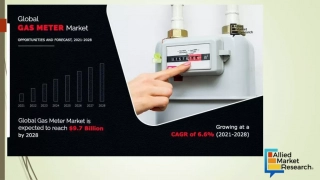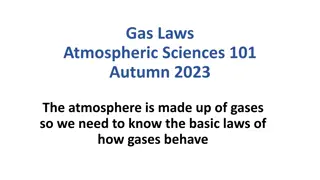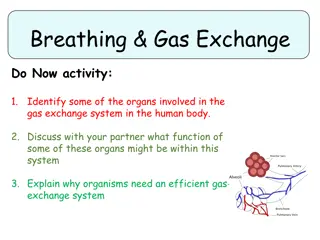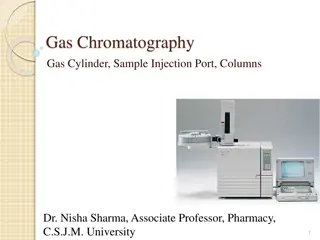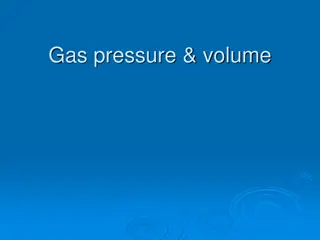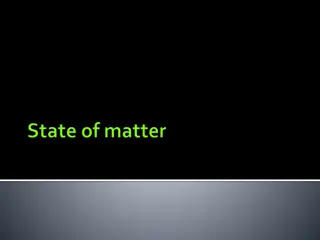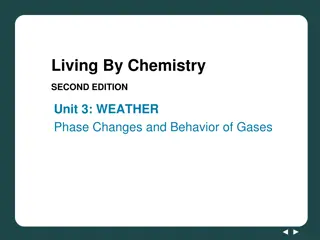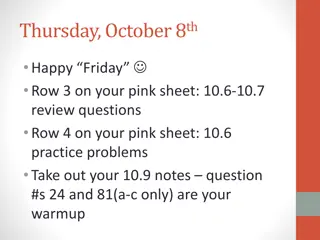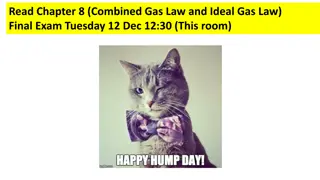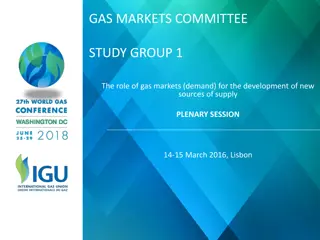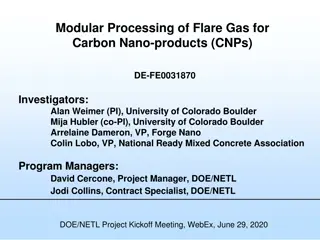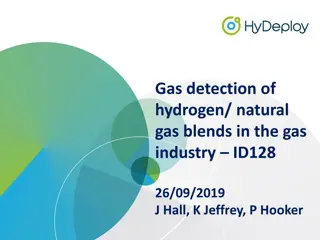Gas Laws and Their Applications
This content covers Boyle's Law, Charles' Law, Gay-Lussac's Law, and the Combined Gas Law, explaining the relationships between pressure, volume, temperature, and how they are interrelated. Gas law problems related to volume and temperature changes are also illustrated through examples.
Download Presentation

Please find below an Image/Link to download the presentation.
The content on the website is provided AS IS for your information and personal use only. It may not be sold, licensed, or shared on other websites without obtaining consent from the author.If you encounter any issues during the download, it is possible that the publisher has removed the file from their server.
You are allowed to download the files provided on this website for personal or commercial use, subject to the condition that they are used lawfully. All files are the property of their respective owners.
The content on the website is provided AS IS for your information and personal use only. It may not be sold, licensed, or shared on other websites without obtaining consent from the author.
E N D
Presentation Transcript
A. Boyles Law Volume (mL) 10.0 20.0 30.0 40.0 Pressure (torr) 760.0 379.6 253.2 191.0 P V (mL torr) 7.60 x 103 7.59 x 103 7.60 x 103 7.64 x 103 PV = k P V
A. Boyles Law The pressure and volume of a gas are inversely related at constant mass & temp PV = k P V
B. Charles Law Volume (mL) 40.0 44.0 47.7 51.3 Temperature (K) 273.2 298.2 323.2 348.2 V/T (mL/K) 0.146 0.148 0.148 0.147 V= k V T T
B. Charles Law The volume and absolute temperature (K) of a gas are directly related at constant mass & pressure V= k V T T
C. Gay-Lussacs Law Temperature (K) 248 273 298 373 Pressure (torr) 691.6 760.0 828.4 1,041.2 P/T (torr/K) 2.79 2.78 2.78 2.79 P= k P T T
C. Gay-Lussacs Law The pressure and absolute temperature (K) of a gas are directly related at constant mass & volume P= k P T T
D. Combined Gas Law P V PV PV T T T P1V1 T1 P1V1T2 =P2V2T1 = k P2V2 T2 =
E. Gas Law Problems A gas occupies 473 cm3 at 36 C. Find its volume at 94 C. CHARLES LAW T V GIVEN: V1 = 473 cm3 T1 = 36 C = 309K V2 = ? T2 = 94 C = 367K WORK: P1V1T2 = P2V2T1 (473 cm3)(367 K)=V2(309 K) V2 = 562 cm3
E. Gas Law Problems A gas occupies 100. mL at 150. kPa. Find its volume at 200. kPa. BOYLE S LAW P V GIVEN: V1 = 100. mL P1 = 150. kPa V2 = ? P2 = 200. kPa WORK: P1V1T2 = P2V2T1 (150.kPa)(100.mL)=(200.kPa)V2 V2 = 75.0 mL
E. Gas Law Problems A gas occupies 7.84 cm3 at 71.8 kPa & 25 C. Find its volume at STP. COMBINED GAS LAW P T V GIVEN: V1=7.84 cm3 P1=71.8 kPa T1=25 C = 298 K V2=? P2=101.325 kPa T2=273 K WORK: P1V1T2 = P2V2T1 (71.8 kPa)(7.84 cm3)(273 K) =(101.325 kPa)V2 (298 K) V2 = 5.09 cm3
E. Gas Law Problems A gas pressure is 765 torr at 23 C. At what temperature will the pressure be 560. torr? GAY-LUSSAC S LAW P T GIVEN: P1 = 765 torr T1 = 23 C = 296K P2 = 560. torr T2 = ? WORK: P1V1T2 = P2V2T1 (765 torr)T2 = (560. torr)(296K) T2 = 216 K = -57 C
B. Daltons Law The total pressure of a mixture of gases equals the sum of the partial pressures of the individual gases. Ptotal = P1 + P2 + ... When a H2 gas is collected by water displacement, the gas in the collection bottle is actually a mixture of H2 and water vapor.
B. Daltons Law Hydrogen gas is collected over water at 22.5 C. Find the pressure of the dry gas if the atmospheric pressure is 94.4 kPa. The total pressure in the collection bottle is equal to atmospheric pressure and is a mixture of H2 and water vapor. GIVEN: PH2 = ? Ptotal = 94.4 kPa PH2O = 2.72 kPa WORK: Ptotal = PH2 + PH2O 94.4 kPa = PH2 + 2.72 kPa PH2 = 91.7 kPa Sig Figs: Round to least number of decimal places. Look up water-vapor pressure on p.899 for 22.5 C.
B. Daltons Law A gas is collected over water at a temp of 35.0 C when the barometric pressure is 742.0 torr. What is the partial pressure of the dry gas? The total pressure in the collection bottle is equal to barometric pressure and is a mixture of the gas and water vapor. GIVEN: Pgas = ? Ptotal = 742.0 torr PH2O = 42.2 torr WORK: Ptotal = Pgas + PH2O 742.0 torr = PH2 + 42.2 torr Pgas = 699.8 torr Sig Figs: Round to least number of decimal places. Look up water-vapor pressure on p.899 for 35.0 C.
C. Grahams Law Diffusion Spreading of gas molecules throughout a container until evenly distributed. Effusion Passing of gas molecules through a tiny opening in a container
C. Grahams Law Speed of diffusion/effusion Kinetic energy is determined by the temperature of the gas. At the same temp & KE, heavier molecules move more slowly. Larger m smaller v KE = mv2


